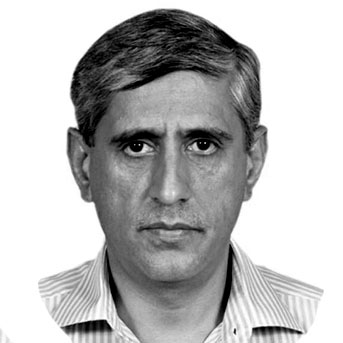Raashid Wali Janjua
SIXTH of September every year reminds one of the classic horsed cavalry charges of yore in the smoky haze of the bomb scarred plains of Chawinda sector. It was a charge that unhinged the implacable momentum of India’s much vaunted 1stArmoured Division, Lieutenant General PO Dunn, the commander 1 Indian Corps had issued instructions for capture of Phillaurah and subsequent assault on Chawinda by 1 Armoured Division. Major General Rajinder Singh, nicknamed sparrow who was commanding Indian 1st Armoured Division (Black Elephant) decided to launch his spearhead brigade to capture Phillaurah from North West. His plan was based on the assumption that the Western flank of Pakistani positions at Phillaurah was unguarded and that he could outflank Pakistani positions to hit Pakistani armour concentrated in Gadgor-Chaubara.
In order to deceive Pakistani defenders about his main attack he decided to move an armoured brigade towards Gadgor, while his schwerpunkt (Main thrust) was on Phillaurah. Indian 1st Armoured Division was ordered to manoeuvre towards Phillaurah on morning of 11 September with three tank regiments moving abreast. 16 Cavalry moving on Western axis was to establish a blocking position at Khananwali. The famed 17 Poona Horse was advancing in the centre to capture Libbe, and 4 Hodson’s Horse was moving in the east to cut RoadPhillaurah-Chaubara at Saboki. Indian 1 Armoured brigade’s main attack with three tank regiments was launched against 11 Cavalry at Phillaurah on 10/11th September. To relieve pressure on 11 Cavalry Guide’s Cavalry was tasked to launch an attack against elements of Indian 16 Cavalry and 17 Poona Horse. Guide’s Cavalry of Pakistan Army was a legendary tank regiment with a history going back to 175 years and was also mentioned in the M. M. Kaye’s classic, “The Far Pavilions”. The regiment was led by Lt Colonel Amir Gulistan Janjua and had Major Fazl-e-Haq (later Brig and Lt Gen respectively and both governors of (erstwhile) NWFP as second in command, while the squadrons were being commanded by Majors Zia uddin Abbasi, Shamim Yaseeen Manto, Abdul Latif Malik and Shah Bahram Khattak. Zia ud Din Abbasi was a debonair young commander of amiable disposition and an infectious sense of humour. Because of above he was very popular amongst the officers and soldiers. He was relied upon for his professional competence by the regiment’s second in command, the redoubtable Fazal-e Haq whose gumption and spirit was the rallying point for entire regiment. Alpha Squadron was being commanded by Major Abdul Latif while Bravo Squadron was commanded by Major Zia ud Din. Both of the squadrons were equipped with M47/48 Patton tanks. The Charlie squadron comprising M36 tank destroyers was commanded by Major Shamim Manto.
On 11th September the reconnaissance troop of Guide’s Cavalry encountered Indian 16 Cavalry South of Bhagowal. The troop fell back towards Wadianwala but Major Fazal-e-Haq reached the site and took control of the situation. In first tank battle three Indian Centurions were knocked down by reconnaissance troop. Alpha and Bravo squadrons were launched in the old fashioned style of horsed cavalry. The M47s/48s belched a smoky commotion while champing at the bits like neighing steeds of yore, their steel frames enclosing a pugnacious spirit of old cavaliers, gingered up by the sight of enemy tanks and the raspy sound of their indomitable commander, Amir Gulistan Janjua, who issued his orders on wireless. The cavaliers personified the spirit of red badge of courage in Stephen Crane’s words, “They were going to look at war, the red animal—war, the blood-swollen god. And they were deeply engrossed in this march.” Alpha Squadron charged for its objective i.e Char and captured it by 2 pm. The squadron commander Major Abdul Latif Malik got wounded but pushed back the Indian 16 Cavalry from Khananwali. As per military historians the war diary accounts of Indian 16 Cavalry are reticent on 16 Cavalry’s actions after 11th September, most probably due to the drubbing it received at the hands of Guide’s Cavalry, first at Wadianwala and then at Char.
The Bravo squadron of the regiment, meanwhile, commanded by Major Zia ud Din Abbasi ran pellmell into a fusillade of anti-tank and tank fire from famed 17 Poona Horse in the area of Gil and Khananwali. As one of his troops got pinned down due to heavy resistance Major Zia ud Din tried to attempt an outflanking manoeuvre and ran into the C squadron of 17 Poona Horse. Major Zia ud Din Abbasi about which an apocryphal story says that his martyrdom was conveyed to a pious clairvoyant in Mecca in dream by Holy Prophet himself, got hit 1000 yards short of his objective by an anti-tank projectile and embraced martyrdom. Thus ended worldly life of an extremely brilliant and popular officer, in the classic tradition of a charger, embracing death in saddle. After his martyrdom the squadron was taken over by his young second in command, Lieutenant Hussain Shah, who also was hit and embraced martyrdom just short of his objective. While this charge finished another threat loomed large on horizon. News of Indian armoured thrust towards Bhagowal was received.
The two squadrons exhausted after a bold charge were told to move west and attack the intruding Indian 62 Cavalry. The squadrons dashed for their new objective and their sudden and bold appearance east of Bhagowal forced Indian armour to withdraw. Thus ended the eventful charge of the Guide’s Cavalry on 11th September at the end of which Indians lost 21 tanks as against six own tanks. The intrepid chargers of Guide’s cavalry had saved the day for Pakistan. 16 Cavalry remained stuck at their location and the attack caused a mental shock to already cautious Indians whose attacking tactics turned timid despite superiority in numbers. The result was slowing of Indian advance and sapping of offensive spirit resulting in unimaginative battering against well held Pakistani positions and refusal to go for bold outflanking manoeuvres.
— The writer, a Retired Brig, is a PhD scholar at NUST, Islamabad.










